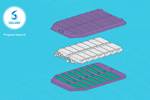Limosa taps Airborne composites expertise to build LimoConnect
Airborne’s capabilities will support airframe prototyping, automated production of the Limosa LimoConnect eVTOL + eCTOL aircraft from prototype through to serial production to help meet 2028 entry-into-service goals.
Airborne Commercial Director Joe Summers (left) and Limosa Inc. Founder and CEO Hamid Hamidi (right). Photo Credit: Airborne
Limosa Inc. (Montreal, Quebec, Canada), an aerospace startup company, and Airborne (The Hague, Netherlands), have agreed on terms for the production of the Limosa LimoConnect aircraft prototype airframe in parallel to designing automated manufacturing lines and supporting Limosa’s industrialization from prototype through to serial production. Under the highly collaborative approach, the partners are targeting a fast ramp-up of Limosa airframe production.
Limosa aims to revolutionize air taxi transportation through the development of the LimoConnect all-electric, 1+7 seater vertical and conventional takeoff and landing (eVTOL + eCTOL) aircraft. According to the company, the strength of LimoConnect is its flexibility to adopt different mission capabilities as well as the capability of takeoff and land conventionally so that it can use existing airports prior to the emergence and certification of new vertiport infrastructures. Type certification under regulations of Transport Canada Civil Aviation (TCCA) and entry into service is planned for 2028.
Airborne’s capability set covers the entire product development cycle for composite structures, from initial feasibility through to serial automated production and the supply of digital manufacturing equipment. These capabilities include design, tooling, stress analysis, prototype production and process development, economic analysis, automation and software development. Limosa Inc. Founder and CEO Hamid Hamidi and Airborne Commercial Director Joe Summers signed the partnership heads of terms on Feb. 8, 2023.
“Design for manufacturability and serviceability is the core mission at Limosa,” Hamidi notes. “The production rate of these new technology vehicles will sit somewhere between automotive and aerospace industry products, so I believe the integration of automated composite manufacturing will be a game changer. I believe that [the] combined automated composite manufacturing capability of Airborne will enable Limosa to mass produce the composite airframe structure by having the environmental issues, such as waste reduction and recyclability, in mind since the very beginning.”
According to Airborne Business Development Manager, responsible for advanced air mobility (AAM), Jamie Snudden, the production rates and technical requirements that are being suggested for AAM are different to any markets that have come before — because of this, a new approach to automation is needed. “There also needs to be a highly collaborative approach taken between design and industrialization functions to ensure trade-offs are fully reviewed and development occurs rapidly to reach the timescales being suggested by OEMs,” Snudden says. “Airborne is looking forward to supporting Limosa in bringing about their vision.”
Related Content
-
Honda begins production of 2025 CR-V e:FCEV with Type 4 hydrogen tanks in U.S.
Model includes new technologies produced at Performance Manufacturing Center (PMC) in Marysville, Ohio, which is part of Honda hydrogen business strategy that includes Class 8 trucks.
-
Composites end markets: Pressure vessels (2024)
The market for pressure vessels used to store zero-emission fuels is rapidly growing, with ongoing developments and commercialization of Type 3, 4 and 5 tanks.
-
Update: THOR project for industrialized, recyclable thermoplastic composite tanks for hydrogen storage
A look into the tape/liner materials, LATW/recycling processes, design software and new equipment toward commercialization of Type 4.5 tanks.

















